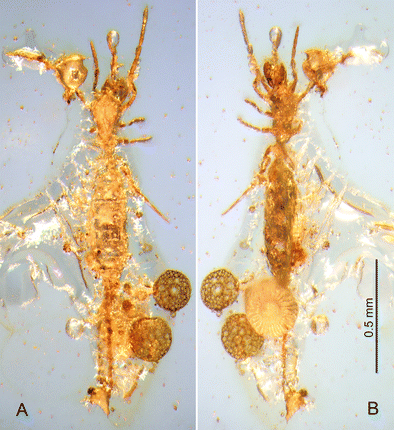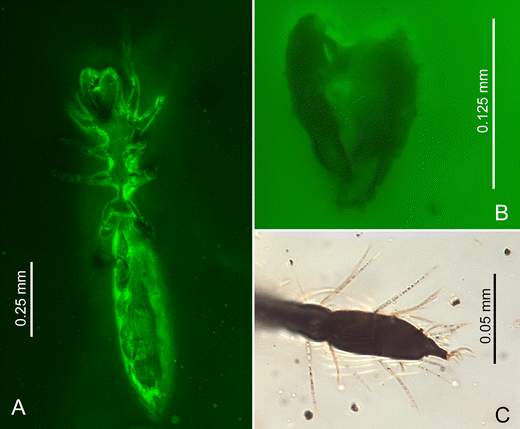It’s smaller than a grain of rice, yellowish, trapped in amber and lived 100 million years ago alongside dinosaurs. Meet Electrokoenenia yaksha, a newly described type of microwhip scorpion, or palpigrade, from Myanmar, whose minute fossilised remains have been found, trapped in Burmese amber. It has been described by an international team led by Michael S. Engel of the University of Kansas and the American Museum of Natural History in the US and Diying Huang of the Nanjing Institute of Geology and Palaeontology in the People’s Republic of China in Springer’s journal The Science of Nature.

Photomicrographs of holotype (NIGP 163253) of Electrokoenenia yaksha Engel and Huang, gen. n. et sp. n., in mid-Cretaceous amber from northern Myanmar. a Dorsal view. b Ventral view
Despite the name, the microwhip scorpion is only distantly related to true scorpions. Engel discovered a single example of Electrokoenenia yaksha while investigating the diversity of arthropods preserved in pieces of Burmese amber from the Hukawng Valley in northern Myanmar. These are kept in the Nanjing Institute of Geology and Paleontology of the Chinese Academy of Sciences.
Many of the finer details commonly used to compare fossilised remains with those of living microwhip scorpions are not visible in the sample. This is because it is contained in amber and it is obscured by microscopic fractures and debris.

Reconstructed habitus of Electrokoenenia yaksha Engel and Huang, gen. n. et sp. n., with meso- and metapeltidia reconstructed as they appear to have been formed (chaetotaxy omitted). a Dorsal habitus. b Expanded detail of reconstructed frontal organ
Nonetheless, the researchers believe the sample to be that of a yellowish female of 1.47 millimetres long that lived some 100 million years ago during the Mesozoic period. It is the first microwhip scorpion fossil from this period to be found, and also the only one of its order known of to be contained in amber. The only other fossil record from this order is encased in limestone from the Onyx Marble Formation, and is therefore in geological terms between 94 and 97 million years younger than Electrokoenenia yaksha. Because it looks so similar to other microwhip scorpions still found today, it most probably shared the same habitat and preferences as its modern-day kin.
![Details of holotype (NIGP 163253) of Electrokoenenia yaksha Engel and Huang, gen. n. et sp. n., in mid-Cretaceous amber from northern Myanmar. a Frontal view of cheliceral chela as preserved (note that the right chela [left in image] is turned such that its leading edge is more angled toward the viewer, while the left is more in profile). b Reconstruction of chela, from observable details. c Detail of dorsal surface of prosoma and anterior legs (the fine lines radiating from body are not setae but rather minute, reflective fractures within the amber itself resulting from weakness around the inclusion)](http://www.worldfossilsociety.org/wp-content/uploads/2016/03/151209183454_1_540x360-2.gif)
Details of holotype (NIGP 163253) of Electrokoenenia yaksha Engel and Huang, gen. n. et sp. n., in mid-Cretaceous amber from northern Myanmar. a Frontal view of cheliceral chela as preserved (note that the right chela [left in image] is turned such that its leading edge is more angled toward the viewer, while the left is more in profile). b Reconstruction of chela, from observable details. c Detail of dorsal surface of prosoma and anterior legs (the fine lines radiating from body are not setae but rather minute, reflective fractures within the amber itself resulting from weakness around the inclusion)

Confocal and microphotographic images of holotype (NIGP 163253) of Electrokoenenia yaksha Engel and Huang, gen. n. et sp. n., in mid-Cretaceous amber. a Ventral view of specimen excluding flagellum. b Frontal view of chela. c Detail of apex of right pedipalp
“Preservation in amber is perhaps the only medium through which such minute animals could be adequately characterized, their fine features and fragile forms too readily destroyed or rendered unidentifiable in sediments,” says Engel. He believes that further specimens might be discovered in amber deposits from India, the Dominican Republic, Lebanon, eastern North America and Archingeay in France.
Key: WFS,Riffin T Sajeev,Russel T Sajeev,World Fossil Society



 March 10th, 2016
March 10th, 2016  Riffin
Riffin  Posted in
Posted in  Tags:
Tags: 